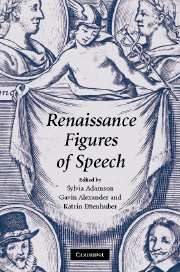Book contents
- Frontmatter
- Dedication
- Contents
- List of illustrations
- List of contributors
- Preface
- Note on spelling and references
- Introduction: the figures in Renaissance theory and practice
- Chapter 1
- Chapter 2
- Chapter 3
- Chapter 4
- Chapter 5
- Chapter 6
- Chapter 7
- Chapter 8
- CHAPTER 8 Paradiastole: redescribing the vices as virtues
- Chapter 9
- Chapter 10
- Chapter 11
- Chapter 12
- Chapter 13
- Notes
- Suggestions for further reading
- Index
CHAPTER 8 - Paradiastole: redescribing the vices as virtues
Published online by Cambridge University Press: 05 February 2014
- Frontmatter
- Dedication
- Contents
- List of illustrations
- List of contributors
- Preface
- Note on spelling and references
- Introduction: the figures in Renaissance theory and practice
- Chapter 1
- Chapter 2
- Chapter 3
- Chapter 4
- Chapter 5
- Chapter 6
- Chapter 7
- Chapter 8
- CHAPTER 8 Paradiastole: redescribing the vices as virtues
- Chapter 9
- Chapter 10
- Chapter 11
- Chapter 12
- Chapter 13
- Notes
- Suggestions for further reading
- Index
Summary
The earliest English rhetorical handbooks in which the figure of paradiastole is named and defined are Henry Peacham's Garden of Eloquence (1577) and George Puttenham's Arte of English Poesie (1589). Peacham places paradiastole in the third order of the rhetorical schemates, and thus among the figures of amplification used to ‘garnish matters and causes’. He turns to consider it immediately after discussing meiosis, to which it is said to be ‘nye kin’, and defines it as follows: ‘Paradiastole … is when by a mannerly interpretation, we doe excuse our own vices, or other mens whom we doe defend, by calling them vertues.’ ‘This figure is used’, he summarises, ‘when vices are excused.’
Puttenham pursues the comparison between meiosis and paradiastole at greater length. If, he argues, ‘you diminish and abbase a thing by way of spight or mallice, as it were to deprave it’, this is an instance of meiosis. The contrast with paradiastole is said to be as follows: ‘But if such moderation of words tend to flattery, or soothing, or excusing, it is by the figure Paradiastole, which therfore nothing improperly we call the Curry-favell, as when we make the best of a bad thing, or turne a signification to the more plausible sence … moderating and abating the force of the matter by craft, and for a pleasing purpose.’
- Type
- Chapter
- Information
- Renaissance Figures of Speech , pp. 149 - 164Publisher: Cambridge University PressPrint publication year: 2007
- 12
- Cited by

